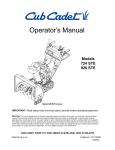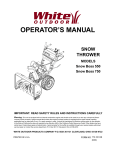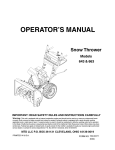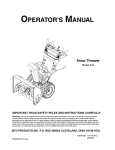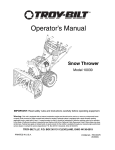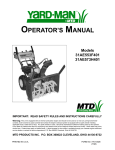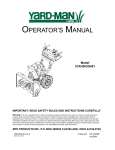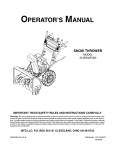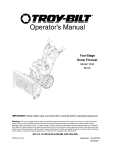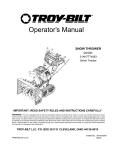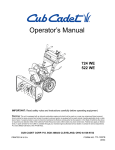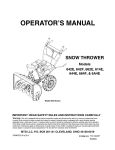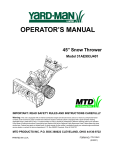Download Cub Cadet 826 4x4 Operator`s manual
Transcript
OPERATOR’S MANUAL SNOW THROWER MODEL 826 4x4 4-Wheel Drive IMPORTANT: READ SAFETY RULES AND INSTRUCTIONS CAREFULLY Warning: This unit is equipped with an internal combustion engine and should not be used on or near any unimproved forestcovered, brush-covered or grass-covered land unless the engine’s exhaust system is equipped with a spark arrester meeting applicable local or state laws (if any). If a spark arrester is used, it should be maintained in effective working order by the operator. In the State of California the above is required by law (Section 4442 of the California Public Resources Code). Other states may have similar laws. Federal laws apply on federal lands. A spark arrester for the muffler is available through your nearest engine authorized service dealer or contact the service department, P.O. Box 368023 Cleveland, Ohio 44136-9722. CUB CADET CORP. P.O. BOX 368023 CLEVELAND, OHIO 44136-9722 PRINTED IN U.S.A. FORM NO. 770-10260A.fm (6/00) TABLE OF CONTENTS Content Page Important Safe Operation Practices................................................................... 3 Assembling Your Snow Thrower ....................................................................... 5 Know Your Snow Thrower ................................................................................. 7 Operating Your Snow Thrower .......................................................................... 8 Making Adjustments .......................................................................................... 10 Maintaining Your Snow Thrower........................................................................ 11 Servicing Your Snow Thrower ........................................................................... 12 Troubleshooting................................................................................................. 16 Parts List............................................................................................................ 17 FINDING MODEL NUMBER This Operator’s Manual is an important part of your new 4-wheel drive snow thrower. It will help you assemble, prepare and maintain the unit for best performance. Please read and understand what it says. Before you start assembling your new equipment, please locate the model plate on the equipment and copy the information from it in the space provided below. The information on the model plate is very important if you need help from our Customer Support Department or an authorized dealer. • You can locate the model number by standing behind the unit in the operating position and looking down at the dash panel. A sample model plate is explained below. For future reference, please copy the model number and the serial number of the equipment in the space below. (Model Number) (Serial Number) Copy the model number here: Copy the serial number here: CUB CADET CORP. P.O. BOX 368023 CLEVELAND, OHIO 44136 CALLING CUSTOMER SUPPORT If you have difficulty assembling this product or have any questions regarding the controls, operation or maintenance of this unit, please call the Customer Dealer Referral Line. Call 1- (800)-528-1009 to reach the Customer Dealer Referral Line. Please have your unit’s model number and serial number ready when you call. See previous section to locate this information. For more details about your unit, visit our website at www.cubcadet.com 2 SECTION 1: IMPORTANT SAFE OPERATION PRACTICES WARNING: This symbol points out important safety instructions which, if not followed, could endanger the personal safety and/or property of yourself and others. Read and follow all instructions in this manual before attempting to operate this machine. Failure to comply with these instructions may result in personal injury. When you see this symbol - heed its warning. WARNING: Engine Exhaust, some of its constituents, and certain vehicle components contain or emit chemicals known to State of California to cause cancer and birth defects or other reproductive harm. DANGER: This machine was built to be operated according to the rules for safe operation in this manual. As with any type of power equipment, carelessness or error on the part of the operator can result in serious injury. This machine is capable of amputating hands and feet and throwing objects. Failure to observe the following safety instructions could result in serious injury or death. Training 5. 1. 6. 7. 2. 3. 4. 5. 6. 7. Read, understand, and follow all instructions on the machine and in the manual(s) before attempting to assemble and operate. Keep this manual in a safe place for future and regular reference and for ordering replacement parts. Be familiar with all controls and their proper operation. Know how to stop the machine and disengage them quickly. Never allow children under 14 years old to operate this machine. Children 14 years old and over should read and understand the operation instructions and safety rules in this manual and should be trained and supervised by a parent. Never allow adults to operate this machine without proper instruction. Thrown objects can cause serious personal injury. Plan your snow throwing pattern to avoid discharge of material toward roads, bystanders and the like. Keep bystanders, helpers, pets and children at least 75 feet from the machine while it is in operation. Stop machine if anyone enters the area. Exercise caution to avoid slipping or falling, especially when operating in reverse. 8. 9. Preparation 1. 2. 3. 4. Thoroughly inspect the area where the equipment is to be used. Remove all door mats, newspapers, sleds, boards, wires and other foreign objects which could be tripped over or thrown by the auger/impeller. Always wear safety glasses or eye shields during operation and while performing an adjustment or repair to protect your eyes. Thrown objects which ricochet can cause serious injury to the eyes. Do not operate without wearing adequate winter outer garments. Do not wear jewelry, long scarves or other loose clothing which could become entangled in moving parts. Wear footwear which will improve footing on slippery surfaces. Use a grounded three wire extension cord and receptacle for all units with electric start engines. Adjust collector housing height to clear gravel or crushed rock surfaces. Disengage all clutch levers before starting the engine. Never attempt to make any adjustments while engine is running, except where specifically recommended in the operator’s manual. Let engine and machine adjust to outdoor temperature before starting to clear snow. To avoid personal injury or property damage use extreme care in handling gasoline. Gasoline is extremely flammable and the vapors are explosive. Serious personal injury can occur when gasoline is spilled on yourself or your clothes which can ignite. Wash your skin and change clothes immediately. a. Use only an approved gasoline container. b. Extinguish all cigarettes, cigars, pipes and other sources of ignition. c. Never fuel machine indoors. d. Never remove gas cap or add fuel while the engine is hot or running. e. Allow engine to cool at least two minutes before refueling. f. Never over fill fuel tank. Fill tank to no more than ½ inch below bottom of filler neck to provide space for fuel expansion. g. Replace gasoline cap and tighten securely. h. If gasoline is spilled, wipe it off the engine and equipment. Move machine to another area. Wait 5 minutes before starting the engine. i. Never store the machine or fuel container inside where there is an open flame, spark or pilot light (e.g. furnace, water heater, space heater, clothes dryer etc.). j. Allow machine to cool at least 5 minutes before storing. Operation 1. 2. 3 Do not put hands or feet near rotating parts, in the auger/ impeller housing or discharge chute. Contact with the rotating parts can amputate hands and feet. The auger/impeller clutch lever is a safety device. Never bypass its operation. Doing so, makes the machine unsafe and may cause personal injury. 3. 4. 5. 6. 7. 8. 9. 10. 11. 12. 13. 14. 15. 16. 17. 18. 19. The clutch levers must operate easily in both directions and automatically return to the disengaged position when released. Never operate with a missing or damaged discharge chute. Keep all safety devices in place and working. Never run an engine indoors or in a poorly ventilated area. Engine exhaust contains carbon monoxide, an odorless and deadly gas. Do not operate machine while under the influence of alcohol or drugs. Muffler and engine become hot and can cause a burn. Do not touch. Exercise extreme caution when operating on or crossing gravel surfaces. Stay alert for hidden hazards or traffic. Exercise caution when changing direction and while operating on slopes. Plan your snow throwing pattern to avoid discharge towards windows, walls, cars etc. To avoid property damage or personal injury caused by a ricochet. Never direct discharge at children, bystanders and pets or allow anyone in front of the machine. Do not overload machine capacity by attempting to clear snow at too fast of a rate. Never operate this machine without good visibility or light. Always be sure of your footing and keep a firm hold on the handles. Walk, never run. Disengage power to the auger/impeller when transporting or not in use. Never operate machine at high transport speeds on slippery surfaces. Look down and behind and use care when in reverse. If the machine should start to vibrate abnormally, stop the engine, disconnect the spark plug and ground it against the engine. Inspect thoroughly for damage. Repair any damage before starting and operating. Disengage all clutch levers and stop engine before you leave the operating position (behind the handles). Wait until the auger/impeller comes to a complete stop before unclogging the discharge chute, making any adjustments, or inspections. Never put your hand in the discharge or collector openings. Always use a clearing tool to unclog the discharge opening. Use only attachments and accessories approved by the manufacturer (e.g. wheel weights, tire chains, cabs etc.). 20. If situations occur which are not covered in this manual, use care and good judgment. Contact your dealer or telephone 1-800-528-1009 for assistance and the name of your nearest servicing dealer. Maintenance And Storage 1. Never tamper with safety devices. Check their proper operation regularly. 2. Disengage all clutch levers and stop engine. Wait until the auger/impeller come to a complete stop. Disconnect the spark plug wire and ground against the engine to prevent unintended starting before cleaning, repairing, or inspecting. 3. Check bolts, and screws for proper tightness at frequent intervals to keep the machine in safe working condition. Also, visually inspect machine for any damage. 4. Do not change the engine governor setting or over-speed the engine. The governor controls the maximum safe operating speed of the engine. 5. Snow thrower shave plates and skid shoes are subject to wear and damage. For your safety protection, frequently check all components and replace with original equipment manufacturer’s (O.E.M.) parts only. “Use of parts which do not meet the original equipment specifications may lead to improper performance and compromise safety!” 6. Check clutch controls periodically to verify they engage and disengage properly and adjust, if necessary. Refer to the adjustment section in this operator’s manual for instructions. 7. Maintain or replace safety and instruction labels, as necessary. 8. Observe proper disposal laws and regulations for gas, oil, etc. to protect the environment. 9. Prior to storing, run machine a few minutes to clear snow from machine and prevent freeze up of auger/impeller. 10. Never store the machine or fuel container inside where there is an open flame, spark or pilot light such as a water heater, furnace ,clothes dryer etc. 11. Always refer to the operator’s manual for proper instructions on off-season storage. Your Responsibility: Restrict the use of this power machine to persons who read, understand and follow the warnings and instructions in this manual and on the machine. The safety labels are given below for your reference. 4 SECTION 2: ASSEMBLING YOUR SNOW THROWER NOTE: Any reference in this manual to the left or right side of the snow thrower is observed from the operator’s position. • • Unpacking • • • • • Raise the upper handle assembly until it locks over the lower handle. Look at lower rear of snow thrower frame to be sure both cables are aligned with cable roller guides. See Figure 3. Remove staples from the top sides and ends of the shipping crate. Set panel aside to avoid tire punctures or personal injury. Remove and discard plastic bag that covers unit. Remove any loose parts included with unit (i.e., Operator’s Manual, etc). Roll unit out of crate. Loose Parts The augers are secured to the auger shaft with two shear bolts and hex lock nuts. If you hit a foreign object or ice jam, the snow thrower is designed so that the bolts may shear. Two replacement shear bolts and nuts are provided for your convenience. Store in a safe place until needed. See Figure 1. Check cables on roller guides Cable Roller Guides Figure 3 Shear Bolts • Hex Lock Nuts Figure 1 Secure the upper handle and lower handle with the two plastic wing knobs, cupped washers and carriage bolts previously removed and tighten the upper two plastic wing nuts. See Figure 4. Upper Shift Rod Assembly Shift Rod Connector Disconnect the spark plug wire and ground it against the engine to prevent unintended starting. • Lower Shift Rod Remove the lower two plastic wing nuts, cupped washers and carriage bolts from each side of the lower handle. See Figure 2. Lower Handle Wing Nuts Handle Panel Figure 4 • Slide the shift rod connector down over the end of the lower shift rod. Tap the connector until it locks on the lower shift rod. See Figure 4. NOTE: If the connector is not properly assembled, the shift rod will pivot and you will not be able to shift gears or change directions. Upper Handle • Wing Nuts, Washers, & Bolts Figure 2 5 If not already attached, slip the cables that run from the handle panel to the chute into the cable guide on top of the engine. See Figure 5. snow thrower, the machine should otherwise move freely. b. Engage the traction control and attempt to move the machine both forward and rearward. You should experience resistance as the wheels should not be turning. • Move the shift lever into the fast reverse (R2) position and repeat the previous steps (a & b). If you experienced resistance either when repositioning the shift lever from 6 to R2 or when attempting to move the machine forward or rearward with the traction control released, your snow thrower’s traction control is in need of adjustment and you should NOT operate the machine before completing the adjustment as follows: Cable Guide Figure 5 Final Adjustments • Loosen the jam nut on the traction control cable and UNTHREAD the cable one full turn. • Recheck the adjustment. • Retighten the jam nut to secure the cable when correct adjustment is reached. If the machine can be moved freely both forward and rearward when the traction control fully depressed, proceed as follows: Auger Control Adjustment Check the adjustment of the auger control as follows: • Push forward on the auger control until the small rubber bumper contacts the upper handle. There should be slack in the cable. See Figure 6. • Release the auger control. The cable should be straight. Make certain you can depress the auger control against the left handle completely. If adjustment is necessary, proceed as follows: • • • • Loosen the jam nut and thread the cable in (for less slack) or out (for more slack) as necessary. See Figure 6. Recheck the adjustment before retightening the jam nut against the cable. • Loosen the jam nut on the traction drive cable and THREAD the cable in one full turn. Recheck the adjustment and repeat adjustment as necessary. Retighten the jam nut to secure the cable when correct adjustment is reached. NOTE: If you are uncertain that you have reached the correct adjustment, refer to Traction Control Adjustment in Adjustment Section. Auger Control Skid Shoe Adjustment The space between the shave plate and the ground can be adjusted by repositioning the skid shoes found on either side of the snow throwers auger housing. For close snow removal, place skid shoes in the low position. Use middle or high position when area to be cleared is uneven. See Figure 7. IMPORTANT: It is NOT recommended that this snow thrower be operated on a gravel surface, as loose stones can be easily picked up and thrown by the machine. If you must operate on a gravel surface, ALWAYS adjust the skid shoes into the HIGH position to allow the shave plate maximum clearance. Z-End Jam Nut Auger Control Cable Adjust skid shoes as follows: Figure 6 • Traction Control and Shift Lever Adjustment • To check the adjustment of the traction control and shift lever, proceed as follows: • Loosen, but do NOT remove, the three hex nuts which fasten the skid shoe to the auger housing. Raise or lower the skid shoe to desired position. NOTE: Make certain the entire base of both skid shoes are against the ground to avoid uneven wear on the skid shoes. When one side does wear out, the skid shoes are reversible. Move the shift lever into sixth (6) position. a. With the traction control (refer to Figure 8) released, squeeze in triggers and gently push the snow thrower forward, then pull it back. Disregarding the overall weight of the 6 • • Retighten the hex nuts loosened earlier. Repeat this adjustment on the skid shoe found on the opposite side of the snow thrower. Tire Pressure The tires are overinflated for shipping purposes. • Check tire pressure, by referring to tire sidewalls for recommended tire pressure. NOTE: If the tire pressure is not equal in all tires, the unit may pull to one side or the other. Skid Shoes WARNING: Maximum tire pressure under any circumstance is 30 psi. Equal tire pressure should be maintained at all times. Excessive pressure (over 30 psi) when seating beads may cause tire/rim assembly to burst with force sufficient to cause serious injury. Hex Nuts Figure 7 SECTION 3: KNOW YOUR SNOW THROWER Traction Control / Auger Control Lock Shift Lever Chute Tilt Control Heated Handles Switch Headlight Auger Drive Control Discharge Chute Trigger Lever Closed Open Electric Chute Rotation Switch Electric Starter Button Primer Switch Box Choke Safety Ignition Key Skid Shoe Throttle Control Auger Recoil Starter Handle Figure 8 WARNING: Read, understand, and follow all instructions and warnings on the machine and in this manual before operating. This same lever also locks the auger control to avoid interruption of the snow throwing process. If the auger control is engaged along with the traction control, the operator can release the auger control (on the left handle) and the augers will remain engaged. Release the traction control to stop both the augers and wheel drive (auger control must also be released). Traction Control / Auger Control Lock The traction control is located on the right handle. Squeeze the traction control to engage the wheel drive. Release to stop. See Figure 8. IMPORTANT: Always release tractional control before changing speeds. 7 Auger Drive Control To change the direction in which discharged snow is thrown, proceed as follows: • Push the toggle switch to the left to rotate the chute counterclockwise. • Push the toggle switch to the right to rotate the chute clockwise. The auger drive control is located on the left handle. Squeeze the control grip to engage the augers. Release to stop the snow throwing action. (Traction control must also be released.) See Figure 8. IMPORTANT: Release the switch once the chute has completed its rotation cycle in either direction. Failure to do so can result in damage to the electric chute motor and/or its drive gear. Trigger Lever The left and right turn triggers are located on the underside of the handles and are used to assist in steering your snow thrower. Squeeze the right trigger lever when turning right and the left trigger lever when turning left. See Figure 8. Headlight The headlight is on whenever the engine is running. Chute Tilt Control Throttle Control The distance snow is thrown can be changed by adjusting the angle of the chute assembly. Move the chute tilt control forward to decrease the distance, toward the rear to increase. See Figure 8. The throttle control is located on the engine. It regulates the speed of the engine and will shut off the engine when pushed down completely. See Figure 8. Skid Shoe Safety Ignition Key The position of the skid shoe is determined by the condition of the ground from where snow has to be removed. See Figure 8. The safety ignition key must be fully inserted in the switch before the unit will start. Remove the ignition key when the snow thrower is not in use. See Figure 8. IMPORTANT: Do NOT attempt to turn the key. Shift Lever Fuel Shut-off Valve The shift lever is located in the center of the handle panel and is used to determine both ground speed and direction of travel. It can be moved into any of eight positions. See Figure 8. The fuel shut-off valve, located under the fuel tank, controls fuel flow from the tank. Always make certain it is in the Open (vertical) position before attempting to start the engine. See Figure 8. Forward Your snow thrower has six forward (F) speeds. Position number one (1) is the slowest. Position number six (6) is the fastest. Heated Handles Switch This switch is located on the right side of the snow thrower dash panel. To activate the heated handles, toggle the switch to the right to generate heat within the handle grips. Toggle the switch to the left to the OFF position after using the snow thrower. See Figure 8. Reverse Your snow thrower has two reverse (R) speeds. R1 is the slower, while R2 is the faster of the two. IMPORTANT: Always release tractional control before changing speeds. NOTE: The heated handles grips are a compliment to, not a substitute for, proper cold weather outerwear for the operator’s hands. It is recommended that the snow thrower operator wear gloves/mittens to avoid extremities of winter while operating this equipment. Electric Chute-Rotation Switch The electric chute-rotation switch is located on the left side of the snow thrower dash panel. See Figure 8. SECTION 4: OPERATING YOUR SNOW THROWER Before Starting Gas And Oil Fill-up Service the engine with gasoline and oil as instructed in the separate engine manual packed with your snow thrower. Read instructions carefully. WARNING: Read, understand, and follow all instructions and warnings on the machine and in this manual before operating. 8 WARNING: Use extreme care when handling gasoline. Gasoline is extremely flammable and the vapors are explosive. Never fuel machine indoors or while the engine is hot or running. Extinguish cigarettes, cigars, pipes an other sources of ignition. • • • • • A plastic cup is provided inside the fuel fill opening on the fuel tank. Remove and discard this cup before filling up the tank. Use the separate fuel tank cap to close after fill-up. • To Start Engine • NOTE: If unit shows any sign of motion (drive or augers) with the clutch grips disengaged, shut engine off immediately. Readjust as instructed in the Final Adjustments in the Assembly Section. • • • • If you have a grounded three-prong receptacle, proceed as follows: Rotate choke knob to OFF position and do not prime engine. Connect power cord to switch box on engine. Plug the other end of power cord into a three-hole, grounded 120 volt AC receptacle. Push starter button on top of the engine to crank engine. As you crank the engine, move choke knob to FULL choke position. When engine starts, release starter button, and move choke gradually to OFF. If engine falters, move choke immediately to FULL and then gradually to OFF. When disconnecting the power cord, always unplug from the three-prong receptacle first and then from the snow thrower. Recoil Starter Attach spark plug wire to spark plug. Make certain the metal loop on end of the spark plug wire (inside the boot) is fastened securely over the metal tip on the spark plug. Make certain the fuel shutoff valve is in the OPEN (vertical position). See Figure 7. Make certain the auger and drive control levers are in the disengaged (released) position. Move throttle control up to FAST position. Insert ignition key into slot. See Figure 7. Be certain it snaps into place. Do not turn key. • • Rotate choke knob to FULL choke position (cold engine start). If engine is warm, place choke in OFF position instead of FULL. Push primer button two or three times. If engine is warm, push primer button once only. NOTE: Always cover vent hole in primer button when pushing. Additional priming may be necessary for first start if temperature is below 15°F. • Grasp starter handle and pull rope out slowly, until it pulls slightly harder. Let rope rewind slowly. Pull starter handle rapidly. Do not allow handle to snap back. Allow it to rewind slowly while keeping a firm hold on the starter handle. Repeat the previous steps until engine starts. NOTE: Engine will not start unless ignition key is inserted into ignition slot in carburetor cover. • Electric Starter • • To Stop Engine • Determine that your house wiring is a three-wire grounded system. Ask a licensed electrician if you are not certain. If your house wiring system is not a three-wire grounded system, do not use this electric starter under any conditions. • • Run engine for a few minutes before stopping to help dry off any moisture on the engine. To help prevent possible freeze-up of starter, proceed as follows. Electric Starter: • WARNING: The electric starter is equipped with a grounded three-wire power cord and plug and is designed to operate on 120 volt AC household current. It must be used with a properly grounded three-prong receptacle at all times to avoid the possibility of electric shock. Follow all instructions carefully prior to operating the electric starter. • Connect power cord to switch box on engine, then to 120 volt AC receptacle. With the engine running, push starter button and spin the starter for several seconds. The unusual sound made by spinning the starter will not harm engine or starter. Disconnect the power cord from receptacle first, and then from switch box. Recoil Starter • If your home electrical system is grounded, but a three-hole receptacle is not available, one should be installed by a licensed electrician before using the electric starter. • 9 With engine running, pull starter rope with a rapid, continuous full arm stroke three or four times. Pulling the starter rope will produce a loud clattering sound, which is not harmful to the engine or starter. Move throttle control to “stop” or “off” position. • Remove ignition key. Do not turn key. Disconnect the spark plug wire from the spark plug to prevent accidental starting while equipment is unattended. • Squeeze the auger control against the left handle. To disengage power to the augers: • Release both the auger control and the traction control, if engaged. The auger control can be locked so you can turn the electric chute directional control without interrupting the snow throwing process. NOTE: Keep it in a safe place. Engine will not start without ignition key. Wipe all snow and moisture from the carburetor cover in the area of the control levers. Also, move control levers back and forth several times. Operating Tips To Engage Drive • NOTE: Allow the engine to warm up for a few minutes. The engine will not develop full power until it reaches operating temperature. With the engine running near top speed, move the shift lever into one of the six FORWARD positions or two REVERSE positions. Select a speed appropriate for the snow conditions that exist. WARNING: The temperature of the muffler and the surrounding areas may exceed 150°F. Avoid these areas. NOTE: Use slower speeds in higher snow and until you are familiar with the operation of the snow thrower. • • Squeeze the traction control against the right handle and the snow thrower will move. Release it and the drive motion will stop. • • • IMPORTANT: NEVER move the shift lever without first releasing the traction control. Doing so will cause premature wear to the drive system’s friction wheel. To Engage Augers • To engage the augers and start the snow throwing action, proceed as follows: • For the most efficient snow removal, remove snow immediately after it falls. Discharge the snow downwind whenever possible. Slightly overlap each previous path. Set the skid shoes 1/4" below the shave plate for normal usage. The skid shoes may be adjusted upward (to lower the shave plate) for hard-packed snow. Adjust downward (to raise the shave plate) when using on gravel or crushed rock. Be certain to follow the precautions found in the To Stop Engine section to prevent possible freeze-up. Clean the snow thrower thoroughly after each use. SECTION 5: MAKING ADJUSTMENTS WARNING: NEVER attempt to make any adjustments while the engine is running, except where specified in the operator’s manual. in the Assembly Section to adjust the traction control. If you are uncertain that you have reached the correct adjustment, proceed as follows: WARNING: Drain the gasoline out of the snow thrower’s tank, or place a piece of plastic film under the gas cap to avoid spillage BEFORE making the adjustment. Skid Shoe Adjustment The space between the shave plate and the ground can be adjusted by raising or lowering the skid shoes. Refer to Skid Shoe Adjustment in the Assembly Section. • Tip the snow thrower forward, allowing it to rest on the auger housing. • Remove the frame cover underneath the snow thrower by removing the six self-tapping screws. • With the traction control released, there must be clearance between the friction wheel and the drive plate in all positions of the shift lever. • With the traction control engaged, the friction wheel must contact the drive plate. See Figure 9. If adjustment is necessary: Auger Control Adjustment Refer to the information found under Final Adjustments in the Assembly Section to adjust the auger control. Chute Assembly Adjustment The distance snow is thrown can be adjusted by adjusting the angle of the chute assembly. Refer to the Chute Tilt Control in the Know Your Snow Thrower Section. • • Traction Control Adjustment • Refer to the information found under Final Adjustment 10 Loosen the jam nut on the traction drive cable. Adjust the cable as necessary. Refer to Figure 6. Retighten the jam nut to secure the cable when correct adjustment is reached. Reassemble the frame cover. IMPORTANT: Make certain to check for correct adjustment of the shift rod as instructed under Final Adjustments in the Assembly Section, before operating the snow thrower. Drive Cable Gear Shaft Shift Lever Hairpin Clip Pivot Rod Friction Wheel Rubber Drive Plate Flat Washer Ferrule Figure 9 Upper Shift Rod Shift Rod Connector Shift Rod Adjustment Hairpin Clip To adjust the shift rod, proceed as follows: • • • • • Remove the hairpin clip and slide the shift rod connector up, to separate the upper shift rod from the lower shift rod. See Figure 10. Place the shift lever into the sixth (6) position. Rotate the shift arm clockwise (from the operator’s position) as far as it will go. Thread the upper shift rod downward until the elbow on its lower end aligns with the hole found in the lower shift rod. Reconnect the upper shift rod to the lower shift rod by reinserting the hairpin clip removed earlier and sliding the shift rod connector back down into place. Lower Shift Rod Shift Arm Figure 10 SECTION 6: MAINTAINING YOUR SNOW THROWER WARNING: Before lubricating, repairing, or inspecting, disengage all clutch levers and stop engine. Wait until all moving parts have come to a complete stop. Disconnect spark plug wire and ground it against the engine to prevent unintended starting. IMPORTANT: Keep all grease and oil off of the rubber friction wheel and aluminum drive plate. Drive and Shifting Mechanism Lubricate at least once a season or after every 25 hours of operation. Remove the rear cover, lubricate any chains, sprockets, gears, bearings, shafts, and shifting mechanism at least once a season. Use engine oil or a spray lubricant. Avoid getting oil on the friction wheel rubber and aluminum drive plate. Refer to Figure 9. Lubrication Engine There is a grease fitting on the top of the axle shaft which drives the rear track drive wheels on both sides of the unit. Grease these fittings every 25 hours or once a season. Refer to the separate engine manual packed with your unit for all engine lubrication instructions. IMPORTANT: When following instructions in separate engine manual for draining oil, be sure to protect frame to avoid oil dripping onto transmission parts. Traction Control / Auger Control Lock The cams on the ends of the control rods which interlock the traction drive and auger drive controls must be lubricated at least once a season or every 25 hours of operation. The cams can be accessed beneath the handle panel. Use a multi-purpose automotive grease. Gear Shaft Lubricate the gear shaft with 6-n-1 grease at least once a season or after every 25 hours of operation (available at automotive stores, or order part number 737-0170). Refer to Figure 9. 11 Electric Chute-Rotation Motor Do not overfill the gear case. Damage to the seals could result. Be sure the vent plug is free of grease in order to relieve pressure. The gear on the electric chute-rotation motor and the base of the discharge chute itself should be lubed with multi-purpose automotive grease once a season. See Figure 11. Auger Shaft At least once a season, remove the shear bolts on the auger shaft. Spray lubricant inside the shaft. Also lubricate the plastic auger bearings at least once a season and grease the fittings on the end of the auger shaft with a standard grease gun. See Figure 12. Lube Gear & Chute Base Vent Plug Grease Fitting Figure 11 Gear Case The gear case is equipped with a grease fitting on the left housing and should be lubricated with Shell Alvania grease EPR00, part number 737-0168 every 25 hours. See Figure 12. Plastic Bearing Shear Bolts Plastic Bearing Figure 12 SECTION 7: SERVICING YOUR SNOW THROWER WARNING: Before servicing, repairing, or inspecting, disengage all clutch levers and stop engine. Wait until all moving parts have come to a complete stop. Disconnect spark plug wire and ground it against the engine to prevent unintended starting. or other components as a result of doing so will NOT be covered by your snow thrower’s warranty. Shave Plate and Skid Shoes The shave plate and skid shoes on the bottom of the snow thrower are subject to wear. They should be checked periodically and replaced when necessary. To remove the skid shoes, proceed as follows: Engine Refer to the separate engine manual packed with your unit for all engine maintenance procedures. • Remove the six carriage bolts, bell washers, and hex nuts which attach them to the snow thrower. • Reassemble new skid shoes with the six carriage bolts, bell washers (cupped side goes against skid shoes) and hex nuts. Make certain the skid shoes are adjusted to be level. To remove shave plate, remove the carriage bolts, bell washers, and hex nuts which attach it to the snow thrower housing. Reassemble new shave plate, making sure heads of the carriage bolts are to the inside of the housing. Tighten securely. Augers • • The augers are secured to the spiral shaft with two shear bolts and hex lock nuts. If you hit a hard foreign object or ice jam, the snow thrower is designed so that the bolts may shear. Refer to Figure 12. If the augers will not turn, check to see if the bolts have sheared. Replacement shear bolts and hex lock nuts have been provided with the snow thrower. When replacing bolts, spray an oil lubricant into shaft before inserting new bolts. Belt Removal And Replacement Auger Belts IMPORTANT:NEVER replace the auger shear bolts with • standard hex bolts. Any damage to the auger gearbox 12 Remove the plastic belt cover by removing the two self-tapping screws. See Figure 13. Self-Tapping Screw Remove Belt Remove Belt Idler Pulley Belt Cover Figure 13 • Remove the three hex nuts and lock washers which attach the auger housing assembly to the frame assembly on each side. See Figure 14. Figure 15 WARNING: Do not attempt to change the auger belt without the help of an assistant. It is very important that one person, standing at the operating position, firmly hold the snow thrower housing to prevent it from tipping while the other person replaces the belt. Failure to comply with this may result in injury. • While lifting up on the handles, bring the frame assembly close to the auger housing and place the two belts on the front and rear engine pulleys. See Figure 16. Push Frame Assembly Push Auger Assembly Hex Nuts & Lock Washers Figure 16 • Figure 14 • • • • Standing in the operating position, lift up on the handles and pull the frame assembly rearward. The frame and the housing will separate and the rear auger belt will come off the pulley. Maintain control of the frame assembly while pulling it. Remove the two belts from the two engine pulleys. See Figure 15. To remove the front auger drive belt, push the idler pulley to the left. The belt brake should move outward and lift the front auger drive belt from the front auger pulley. Place new belts on the two auger pulleys making sure that the front auger belt is under the belt brake. Route belts under and to the left of the flat idler pulley. Hold the belts upward in this position. Level the frame assembly and tip the auger housing forward to align studs with the corresponding holes on both sides of the frame assembly. NOTE: Use care to avoid pinching the control cable. • • From the frame assembly side, insert the six lock washers and hex nuts previously removed onto the studs. Tighten nuts securely. See Figure 14. Reinstall the belt cover on the front of the engine with the two self-tapping screws and flat washers. NOTE: Make sure that the auger cable is routed in front of the belt. Drive Belt • 13 Drain the gasoline from the snow thrower or place a piece of plastic under the gas cap. • • • • • Remove the plastic belt cover on the front of the engine by removing the two self-tapping screws. Tip the snow thrower up and forward, so that it rests on the housing. Remove six self-tapping screws from the frame cover underneath the snow thrower. Pull the idler pulley away from the drive belt and remove the belt from the engine pulley. Working from the underside of the frame, slip belt between the friction wheel and the friction wheel disc. You may have to twist the belt flat in order to slide it through the clearance between the friction wheel and the friction wheel disc. Remove and replace the belt. Reassemble following the instructions in reverse order. See Figure 17. Drive Cover Friction Wheel Pin Friction Wheel Spacer Sprocket Gear Shaft Friction Wheel Disc Drive Belt Figure 18 Figure 17 • Servicing Friction Wheel Rubber • The rubber on the friction wheel is subject to wear and should be checked after 25 hours of operation, and periodically thereafter. Replace the friction wheel rubber if any signs of wear or cracking are found. • • • • • • Drain the gasoline from the snow thrower or place a piece of plastic under the gas cap. Tip the snow thrower up and forward, so that it rests on the housing. Remove six screws from the frame cover underneath the snow thrower. Remove the left wheels from the axle. Remove the four screws securing the left drive cover to the frame. Remove the drive cover from the side of the frame. See Figure 18. Holding the friction wheel assembly, slide the gear shaft out of the left side of the unit. The spacer on the right side of the gear shaft will fall and the sprocket should remain hanging lose in the chain. See Figure 18. Lift the friction wheel assembly out between the axle shaft and the drive shaft assemblies. Remove the six screws from the friction wheel assembly (three from each side). Remove the friction wheel rubber from between the friction wheel plates. See Figure 19. Screws Friction Wheel Rubber Hub Screws Friction Wheel Plates Figure 19 14 • • • • Reassemble new friction wheel rubber to the friction wheel assembly, tightening the six screws in rotation and with equal force. Insert the pin from the shift arm assembly into the friction wheel assembly and hold assembly in position. Refer to Figure 18. Slide the gear shaft through the left side of the housing and through the friction wheel assembly. Insert the gear shaft through the sprocket and the spacer. Make certain that the chain engages both the large and the small sprocket. Refer to Figure 18. WARNING: Drain fuel into an approved container outdoors, away from an open flame. Allow engine to cool. Extinguish cigarettes, cigars, pipes, and other sources of ignition prior to draining fuel. Fuel left in engine for extended periods deteriorates and will cause starting problems. If unit is to be stored over 30 days, prepare for storage as follows: • NOTE: If the sprocket fell from the snow thrower while removing the hex shaft, place the sprocket on the hex shaft. Position the hex hub of the sprocket toward the friction wheel when sliding the sprocket on to the hex shaft. • • • • Align the gear shaft with the right hand bearing and carefully guide the left hand bearing into the left side of the housing. Reassemble the drive cover with the four screws that were previously removed. Remove gasoline from carburetor and fuel tank to prevent gum deposits from forming on these parts and causing possible malfunction of engine. Run engine until fuel tank is empty and engine stops due to lack of fuel. Drain carburetor by pressing upward on bowl drain, located below the carburetor cover. NOTE: Fuel stabilizer is an acceptable alternative in minimizing the formation of fuel gum deposits during storage. Do not drain carburetor if using fuel stabilizer. • • NOTE: If you placed plastic under the gas cap, be certain to remove it. Off-season Storage • WARNING: Never store the machine or fuel container indoors where there is an open flame, spark, or pilot light such as on water heater, furnace, clothes dryer, or other gas appliance. • Wipe equipment with an oiled rag to prevent rust. Remove spark plug and pour one ounce of engine oil through spark plug hole into cylinder. Cover spark plug hole with rag. Crank engine several times to distribute oil. Replace spark plug. Follow the lubrication recommendations found in the Maintenance Section. Always store the snow thrower in a clean, dry area. NOTE: When storing any type of power equipment in an unventilated or metal storage shed, care should be taken to rust proof the equipment. Using a light oil or silicone, coat the equipment, especially any chains, springs, bearings and cables. 15 SECTION 8: TROUBLE SHOOTING GUIDE Trouble Possible Cause(s) Engine fails to start 1. Corrective Action Fuel tank empty, or stale fuel. 1. Blocked fuel line. Choke not in the ON position Faulty spark plug. Safety key not in ignition switch on engine. Spark plug wire disconnected. Primer button not being used properly. Fuel shut-off valve closed. 2. 3. 4. 5. Fill tank with clean, fresh gasoline. Fuel becomes stale after thirty days. Clean the fuel line. Move switch to the ON position Clean, adjust gap or replace. Insert the key fully into the switch. 6. 7. Connect spark plug wire. Refer to the engine manual. 8. Open fuel shut-off valve. Unit running on CHOKE. Blocked fuel line or stale fuel. 1. 2. Move the choke lever to OFF position. Clean the fuel line; fill the tank with clean, fresh gasoline. 3. Water or dirt in the fuel system. 3. Drain the fuel tank and carburetor. Refill with fresh fuel. Loss of power 1. 2. Spark plug wire loose. Gas cap vent hole plugged. 1. 2. Connect and tighten spark plug wire. Remove ice and snow from gas cap. Be certain vent hole is clear. Excessive vibration 1. Loose parts or damaged auger. 1. Stop the engine immediately and disconnect the spark plug wire. Tighten all bolts and nuts. If vibration continues, have the unit serviced by an authorized service dealer. Unit fails to propel itself 1. Traction control cable in need of adjustment. Drive belt loose or damaged. 1. Adjust traction control cable. Refer to Making Adjustments Section. Replace drive belt. Refer to the Service Section. Discharge chute clogged. 1. Foreign object lodged in auger. Auger control cable in need of adjustment. Auger belt loose or damaged. Shear bolt sheared. 2. Electric chute fails 1. to turn 2. Loose electrical connections. Blown Fuse. 1. 2. Make sure all connections are tight and fully installed. Replace with new 5 amps fuse. (Fuse is located under handle panel near switch connector.) Electric chute turns in opposite direction of the switch 1. Switch connector installed backwards 1. Unplug the switch connector under the handle panel. Turn connector 180° and reconnect. Heated grips are not creating heat 1. Loose electrical connections. 1. 2. Blown fuse. 2. 3. Faulty heated handles grip. 3. Under the handle panel, check connections from the handles to the wiring harness. Replace with new 5 amps fuse under the handle panel near crank switch connector. Have the grips checked at an authorized service dealer. NOTE: If one heated handles grip fails, both grips will not function. 2. 3. 4. 5. 6. 7. 8. Engine runs erratic 1. 2. 2. Unit fails 1. to discharge snow 2. 3. 4. 5. 2. 3. 4. 5. Stop engine and disconnect spark plug wire. Clean discharge chute and inside of auger housing. Stop engine immediately and disconnect spark plug wire. Remove object from auger. Adjust auger control cable. Refer to the Making Adjustments Section. Refer to Service Section. Replace shear bolt. NOTE: For repairs beyond the minor adjustments listed above, please contact your local Cub Cadet dealer. 16 Model 826 1 17 6 8 14 13 9 6 18 14 6 8 14 16 7 8 2 15 13 12 3 10 4 23 8 14 19 16 22 2 Ref. No. 1. 2. 3. 4. 5. 6. 7. 8. 9. 10. 12. 13. 14. 15. 16. 17. 18. 19. 20. 21. 22. 23. Part No. 710-0459A 710-0599 712-0116 713-0491 713-0492 714-0161 736-0235 736-0351 737-0170 737-3000 738-1135A 738-1136A 741-0598 756-0313 784-0400A 784-0401A 618-0420A 618-0421A 634-0195 734-1732 734-1735 741-0401 734-0255 Description 21 20 Special Hex Screw: 3/8-24 x 1.5” TT Screw: 1/4-20 x 0.5” Jam Nut Sprocket Chain Key Flat Washer Flat Washer Lubricant: 6in 1 Lube Fitting Drive Axle Wheel Axle Hex Flange Bearing Flat Idler Chain Case: Outer Chain Case: Inner Chain Case Assembly RH Chain Case Assembly LH Complete Wheel Assembly Tire Assembly Rim Assembly Bearing Air Valve 17 Model 826 29 9 30 5 25 22 39 27 3 6 20 17 1 18 13 18 13 22 14 10 23 2 16 18 19 4 22 6 12 60 35 7 22 6 59 15 36 22 13 22 28 38 31 33 11 21 28 21 26 40 8 32 44 51 33 49 53 56 48 41 54 45 46 50 57 43 47 52 42 55 43 18 23 34 10 Model 826 Ref. No. 1. 2. 3. 4. 5. 6. 7. 8. 9. 10. 11. 12. 13. 14. 15. 16. 17. 18. 19. 20. 21. 22. 23. 25. 26. 27. 28. 29. 30. Part No. 05931A 684-0065 705-5226 710-0451 710-0459A 710-0604 710-0703 710-0890A 712-0116 712-0324 712-0429 712-0798 712-3010 712-3068 715-0114 731-1379B 732-0611 736-0119 736-0169 736-0167 736-0188 736-0242 736-0463 738-0281 741-0245 741-0309 741-0493A 756-0178 784-5632A Description Bearing Housing Impeller Assy. 12” dia. Chute Reinforcement Carriage Bolt 5/16-18 x .75” Gr.2 Hex Screw 3/8-24 x 1.5” Gr.5 Hex Screw 5/16-18 Carriage Screw 1/4-20 x .75” Shear Bolt 5/16-18 x 1.5” Jam Nut 3/8-24 Hex Lock Nut 1/4-20 Hex Lock Nut 5/16-18 Hex Nut 3/8-16 Gr.2 Hex Nut 5/16-18 Gr.5 Hex Patch Nut 5/16-18 Spiral Pin Chute Adapter Extension Spring Lock Washer Lock Washer Wave Washer Flat Washer Belleville Washer Flat Washer Shoulder Screw Hex Flange Bearing Flange Ball Bearing Flange Bushing Flat Idler Auger Idler Arm Ref. No. 31. 32. 33. 34. 35. 36. 37. 38. 39. 40. 41. 42. 43. 44. 45. 46. 47. 48. 49. 50. 51. 52. 53. 54. 55. 56. 57. 59. 60. Part No. 605-5192A 605-5193A 618-0415A 784-5579A 710-0451 712-3010 736-0242 784-5038B 684-0040C 784-5618 618-0123 618-0124 710-0642 711-0909A 714-0161 715-0143 717-0528 717-0526 718-0186 721-0325 721-0327 736-0351 736-0369 736-0445 741-0662 741-0663 737-3000 736-0231 710-0276 NOTE: For painted parts, please refer to the list of color codes below. Please add the applicable color code, wherever needed, to the part number to order a replacement part. For instance, if a part, numbered 700-xxxx, is painted Cub Yellow, the part number to order would be 700-xxxx-0716. Cub Yellow: 0716 Cub Beige: 0499 Cub Blue: 0685 Powder Black: 0637 19 Description Spiral Assembly: RH 26” Spiral Assembly: LH 26” Gear Assembly: Auger 26” Shave Plate: Auger 26” Carr. Bolt: 5/16-18 x 0.75 Hex Nut: 5/16-18 Gr.5 Belleville Washer Slide Shoe Auger Housing Assy. 26” Bearing Housing RH Housing LH Housing TT Screw, 1/4-20 x .75 Spiral Axle, 26” Hi-Pro Key, 3/16 x 5/8 Spring Spiral Pin, .25 x 1.25 Worm Gear, 20T Worm Shaft Thrust Collar Grease Plug Grease Seal Flat Washer .76 x 1.5 x .030 Flat Washer .508 x 1.0 x .020 Flat Washer .76 x 1.5 x .060 Flange Bearing .75 x 1.0 x .59 Flange Bearing .503 ID x .75 OD Grease Fitting Flat Washer Carriage Screw: Special Model 826 43 44 42 54 48 13 37 13 50 9 48 37 4 49 56 15 27 39 18 32 59 16 38 33 47 2 52 11 7 22 33 39 40 46 40 33 20 23 8 25 16 19 22 33 38 60 21 31 6 14 41 34 24 34 45 28 23 39 1 3 11 32 55 18 13 17 29 57 41 51 10 15 5 12 11 13 48 53 13 20 37 16 30 23 Model 826 Ref. No. 1. 2. 3. 4. 5. 6. 7. 8. 9. 10. 11. 12. 13. 14. 15. 16. 17. 18. 19. 20. 21. 22. 23. 24. 25. 27. 28. 29. 30. 31. 32. 33. 34. Part No. 618-0043 618-0044 618-0303A 618-0420A 618-0421A 656-0012A 684-0014B 684-0042C 684-0130 684-0131A 710-0599 710-0788 710-1652 711-1267 711-1268 711-1364 712-0711 712-3017 713-0131 713-0233 713-0413 713-0473 714-0104 714-0474 716-0102 732-0209 732-0264 736-0105 736-0142 736-0160 736-0169 736-0351 736-0626 Ref. No. 37. 38. 39. 40. 41. 42. 43. 44. 45. 46. 47. 48. 49. 50. 51. 52. 53. 54. 55. 56. 57. 58. 59. 60. Description Dogg Assembly: RH Dogg Assembly: LH Shift Assembly: Steerable Drive Chain Case Assembly: RH Chain Case Assembly: LH Friction Wheel Disc Assy. Shift Rod Assembly Bearing Transmission Frame Assembly Support Bracket Assembly Hex Washer Screw 1/4-20 x 0.5” Hex Washer Screw 1/4-20 x 1.0” Hex Washer Screw 1/4-20 x .625” Drive Shaft Actuator Shaft Pin Jam Nut 3/8-24 Gr.8 Hex Nut: 3/8-16 Chain Chain Sprocket: 19T Sprocket Cotter Pin Cotter Pin Snap Ring Extension Spring Extension Spring Bell Washer Flat Washer Flat Washer Lock Washer Flat Washer Flat Washer 21 Part No. 738-0924 741-0598 741-0600 741-0701 741-1111 746-0897 746-0898 746-0956 748-0190 750-1161A 750-1162 756-0625 784-5590 784-5687A 784-5689A 784-5730A 784-5732 784-5733 784-5740 710-1233 712-0127 725-0157 746-0950 784-5731A 777D03040 777D03165 777D04558 777D04559 777D04560 777I20508 777I20724 777S30511 777S30514 Description Shoulder Screw Hex Flange Bearing Ball Bearing Flange Bushing Hex Flange Bearing Auger Clutch Cable Drive Clutch Cable Steering Cable Spacer Support Tube: Axle Spacer Roller Cable Shift Bracket Auger Clutch Cable Guide Bracket Front Support Guide Bracket Retaining Shaft RH: Actuator Drive Frame Cover Roller Bracket: Drive Cable Retaining Shaft LH: Actuator Drive Oval C-Sunk Machine Screw Weld Nut Cable Tie (not shown) Turn Trigger Frame Label: Auger Side 4x4 Label: Heated Handle Label: Handle Panel Label: Housing 826 4x4 Label: Engine Label: H-Steer LH Label: H-Steer RH Label: Chute Danger Label: Housing Danger Model 826 29 30 7 31 10 28 27 3 11 26 14 20 25 2 21 23 23 8 18 3 21 13 23 15 5 1 9 6 12 22 16 4 19 24 22 Model 826 Ref. No. 1. 2. 3. 4. 5. 6. 7. 8. 9. 10. 11. 12. 13. 14. 15. Part No. 05896A 710-0230 710-0627 710-0654A 710-0696 710-1245 710-1652 710-3005 712-0181 731-1324 732-0710 736-0242 736-0247 736-0270 736-0331 Description Idler Bracket Hex Bolt 1/4-28 x 0.5” Gr.5 Hex Scr w/ Patch: 5/16-24 x 0.75” Hex Washer Head Sems Screw Hex Bolt 3/8-24 x .875” Gr.8 Hex Scr w/ Patch: 5/16-24 x .875” Hex Washer Head TT Hex Screw: 3/8-16 x 1.0” Top Lock Jam Nut: 3/8-16 Belt Cover Extension Spring Bellevile Washer Flat Washer Bell Washer Bell Washer Ref. No. 16. 18. 19. 20. 21. 22. 23. 24. 25. 26. 27. 28. 29. 30. 31. IMPORTANT: For a proper working machine, use Factory Approved Parts. V-BELTS are specially designed to engage and disengage safely. A substitute (non OEM) V-Belt can be dangerous by not disengaging completely 23 Part No. 736-0505 748-0234 748-0360 754-0346 754-0430A 756-0313 756-0569 756-0967 756-0986 756-0987 629-0071 OEM-390-987 712-0324 736-0173 732-0705 Description Flat Washer Shoulder Spacer Adapter Pulley V-Belt Belt Flat Idler Pulley Half Auger Pulley Pulley Half Pulley Half Extension Cord Electric Start Kit Lock Nut 1/4-20 Flat Washer .28 ID x .74 OD Cable Guide 68 Model 826 57 58 27 57 58 55 65 72 70 53 73 72 27 69 82 71 27 68 80 74 63 59 67 58 69 27 56 64 66 77 60 66 62 81 76 78 58 54 31 45 79 11 83 75 61 29 9 15 51 40 13 46 37 13 47 5 8 2 5 14 24 17 20 22 10 14 21 3 50 9 11 40 18 16 41 12 4 25 26 1 31 43 9 11 42 27 15 19 35 39 14 35 52 36 38 48 10 49 For Reference Only 23 44 44 For Reference Only 28 30 32 24 7 Model 826 Ref. No. Part No. Ref. No. Part Description Part No. 736-0242 Part Description 1. 684-0008A Shift Arm Assembly 44. Belleville Washer 2. 710-0262 Carriage Bolt 5/16-18 x 1.5” 45. 736-0506 Special Washer 3. 710-0449 Carriage Bolt 5/16-18 x 2.25” 46. 746-0896 Control Cable 4. 710-0788 TT Screw 1/4-20 x 1” 47. 746-0901 Control Cable 5. 710-0837 C-Sunk Screw #10-16x 0.625” 48. 750-1232 Spacer 7. 710-3008 Hex Screw 5/16-18 x .75” 49. 782-0599 Motor Bracket 8. 711-0677 Ferrule 50. 784-5594 Cable Bracket 9. 712-0429 Hex Lock Nut 5/16-18 51. 784-5604 Handle: Chute Tilt 10. 712-3010 Hex Nut 5/16-18 52. 629-0936 Harness Assembly: Upper 11. 714-0104 Cotter Pin 53. 684-0036 Handle Assembly RH 12. 720-0284 Handle Knob 54. 684-0037 Handle Assembly LH 13. 725-1757 Heated Grip 55. 710-1003 Special Hex Screw 14. 736-0242 Belleville Washer 56. 712-0271 Hex Sems Nut: 1/4-20 15. 736-0275 Flat Washer 57. 712-0693 Hex Nut 16. 736-0451 Saddle Washer 58. 716-0398 Lock Ring: Toggle Switch 17. 747-0620A Shift Rod: Upper 59. 720-0232 Shift Knob 18. 747-0621 Shift Rod: Lower 60. 725-1672 Lamp Housing 19. 749-0951 Lower Handle 61. 725-1755 Toggle Switch: Double Throw 20. 749-0952A Upper Handle: L Style RH 62. 725-1756 Toggle Switch: Single Throw 21. 749-0953A Upper Handle: L Style LH 63. 725-1759 Halogen Lamp: 50W, 12V 22. 750-0963 Connector: Shift Rod 64. 726-0152 Mounting Clamp 23. 618-0419 Gear Assembly: Ring 65. 731-2276 Handle Panel 24. 629-0937 Electric Harness: Lower 66. 736-0226 Flat Washer 25. 710-0262 Carriage Bolt: 5/16-18 x 1.5” 67. 747-1136 Headlight Retainer 26. 710-0451 Carriage Bolt: 5.16-18 x .750” 68. 714-0507 Cotter Pin: 3/32 x .75 27. 710-0599 TT Screw: 1/4-20 x 0.5” 69. 747-0877 Cam Rod 28. 710-0602 TT Screw: 5/16-18 x 1” 70. 784-5680 RH Handle Support Bracket 29. 710-0805 Hex Screw: 5/16-18 x 1.5” 71. 784-5679 LH Handle Support Bracket 30. 710-0817 TT Screw: 5/16-18 x 1.25” 72. 748-0362 Cam Handle Lock 31. 710-0896 Hex Screw AB:1/4-14 x 0.625” 73. 748-0363 Handle Lock Pawl 32. 710-3008 Hex Screw: 5/16-18 x .75” 74. 732-0145 Compression Spring: .36 x 1.0 35. 712-3027 Hex Flange Lock Nut 75. 710-0459A Hex Cap Screw: 3/8-24 x 1.5 36. 724-0249 Electric Motor: Chute Crank 76. 784-5619A Shift Handle 37. 725-0157 Cable Tie 77. 712-0116 Jam Nut, 3/8-24 38. 731-0851A Chute Flange Keeper 78. 732-0193 Comp. Spring: .39 x .6 x .88 39. 731-1300A Lower Chute 79. 736-0105 Bell Washer 40. 731-1313C Cable Guide: Chute Tilt 80. 784-5682 RH Handle Support Bracket 41. 731-1320 Upper Chute 81. 784-5681 LH Handle Support Bracket 42. 731-2279 Motor Cover: Chute Rotation 82. 711-0653 Clevis Pin 43. 736-0159 5/16 Washer 83. 684-0102 Handle Panel Assembly 25 Notes 26 27 MANUFACTURER’S LIMITED WARRANTY FOR: TWO-YEAR RESIDENTIAL ONE-YEAR COMMERCIAL Proper maintenance of your Cub Cadet equipment is the owner’s responsibility. Follow the instructions in your operator’s manual for correct lubricants and maintenance schedule. Your Cub Cadet dealer carries a complete line of quality lubricants and filters for your equipment’s engine, transmission, chassis and attachments. Riding mowers, lawn tractors, garden tractors, Cub Cadet attachments and home maintenance products This limited warranty for residential users, covers any defect in materials or workmanship in your Cub Cadet equipment for two years from the date of purchase for the first user purchaser. We will replace or repair any part or parts without charge through your authorized Cub Cadet dealer. Batteries have a one-year prorated limited warranty with 100% replacement during the first three months. V-belts for either the traction drive or any attachments are covered for one year only. Cub Cadet equipment used commercially is warranted for one year only. (Commercial use is defined as either having hired operators or used for income producing purposes.) Items not covered The warranty does not cover routine maintenance items such as lubricants, filters (oil, fuel, air and hydraulic), cleaning, tune-ups, brake and/or clutch inspection, adjustments made as part of normal maintenance, blade sharpening, set-up, abuse, accidents and normal wear. It does not cover incidental costs such as transporting your equipment to and from the dealer, telephone charges or renting a product temporarily to replace a warranted product. There is no other express warranty. How to obtain service Contact your authorized Cub Cadet servicing dealer who sold you your Cub Cadet equipment. If this dealer is not available, see the Consumer Yellow Pages under “lawn mowers” for the name of a dealer near you. If you need further assistance in finding an authorized Cub Cadet servicing dealer, contact: Cub Cadet Corporation Post Office Box 368023 Cleveland, Ohio 44136 How does state law apply? This limited warranty gives you specific legal rights, and you may also have other rights which vary from state to state.




























